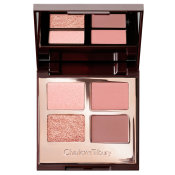
Makeup doesn’t always get along. You learned the hard way to keep the concealer far away from the highlighter, like fighter fish in your makeup bag. But what about foundation and primer? If your combo of choice left you with a gravelly texture or a shade of beige you didn’t even know existed, you might just need a few tips from Cristina Bartolucci, chief creative director of NYX and co-founder of DuWop.
According to Bartolucci, there are two basic methods for using these two products together: one is primer first with foundation layered on top, and the other is actually mixing your primer and foundation together. “It all depends on the results you’re looking for. Primer works on the principle of layers, so if you want that full effect, you need to do it in steps,” says Bartolucci. But that doesn’t mean she never mixes. “That method is great if you want lighter coverage. Modern primers have all sorts of great skincare ingredients and wonderful textures. Mix them with makeup and you get a super-charged, tinted moisturizer that can work beautifully.”
Here are the basic steps for getting both methods right, plus some primer FAQs.
Method 1: Primer, Then Foundation | full coverage
1: Apply primer in a thin layer all over the face, then smooth and fill.
2: Let it set for just a minute.
3: Lightly dot and blend foundation only where you need it (on the cheeks, forehead, chin); you don’t need to coat the whole face.
Method 2: Primer + Foundation, Mixed | lighter coverage
1: In the palm of your hand, mix your primer and foundation with your other index finger. A fifty-fifty combo will give you the effect of a light, tinted moisturizer. Bartolucci likes 2/3 foundation to 1/3 primer for a medium coverage effect.
2: When it’s well-blended, dot the mixture onto your forehead, nose, cheeks, and chin, then blend well. Avoid rubbing large amounts all over your face—it might turn mask-like.
3: If your primer made the finish more dewy than you wanted, dust translucent powder to set. If your primer contains a mattifier, you can skip this step.
When shopping for primers and foundations, how do we know what will work best together?
“You have to experiment. There’s a theory you should never mix silicone- or water-based products with oil-based products, but this isn’t always true. It’s about how much of one ingredient is present and how the pigments are suspended in the formula.” (At the makeup counter, Bartolucci recommends mixing small amounts of tester primer and foundation on your hand. You’ll be able to tell immediately if the combination spreads smoothly.)
Do you have suggestions for good matches of primers and foundations?
“If your skin is dry, try Laura Mercier Hydrating Primer. It works with most textures of foundation and provides just enough moisture to make the foundation glide on without looking oily.”
What about “High Definition” products?
“Always match an HD primer with an HD foundation. Otherwise, you don’t get the full benefit of the technology.” For example, if you use Make Up For Ever HD Invisible Coverage Foundation, pair it with Make Up For Ever HD Microperfecting Primer.
Can silicone-based primers alter the texture of certain foundations?
“Foundations that are really delicate, like Vincent Longo's Water Canvas or Chanel's Vitalumiere Aqua, might break up when applied over a heavy, silicone-based primer.” If your usual base is a light formula, Bartolucci recommends Hourglass Veil Mineral Primer.
Photo: Emma Kim / Image Source




